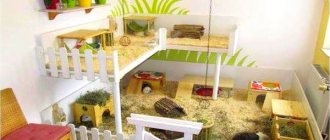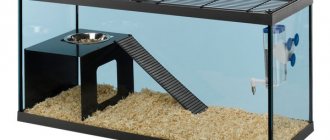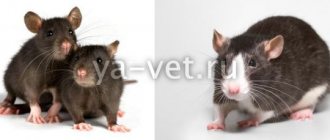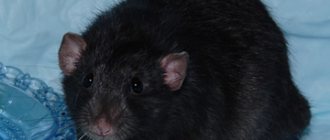Sly beady eyes, small neat ears, a funny elongated mustachioed muzzle, a long catchy tail and an extraordinary mind. This is a decorative rat. And so you succumbed to the charm of this cute rodent and decided to have him as a pet. But where to put the little animal?
It is important to approach the choice of a home for a rat with maximum responsibility and arrange it according to all the rules. After all, only then will the pet feel comfortable and please its owner. Find out what the right cages for decorative rats should be like, how to arrange a rat’s home, and how to care for it.
Features of a cage for domestic rats
For the animal, it is advisable to arrange a cage in which the rat will be kept. The main task in organizing a cage for a decorative rat is to make it large, comfortable and safe for the animal to live in. There are families who immediately let the animal roam freely throughout the property. This is undoubtedly a plus for his freedom, but a decorative rat must have its own personal and safe space.
What should a cell be like?
It is advisable to make the rat’s home where no one and nothing will disturb it. It should be noted that the decorative rat is very concerned about cleanliness, so you need to pay special attention to the tray in it. It is advisable to choose a tall tray, at least 10 cm. Then, during active games in the cage, the filler with which the tray is covered will be inside and will not fly apart.
It is not advisable to use metal and wooden pallets - they are most susceptible to getting wet or rusting, rodents easily deform them, i.e. they are not durable. It is more practical to use pallets made of durable plastic. They are easy to remove odor and wash. When purchasing, you need to pay attention to the quality of the plastic so that there is no strong chemical smell, chips or cracks.
From the above, it is clear that the ideal option for a decorative rat is a large cage with a plastic tray and strong rods. In this case, it is very important to take into account how many animals the cage is purchased for.
What size should the cage be?
The minimum cage size when placing one or two animals should be 60x40 cm in size and at least 50 cm in height. If a larger number of rodents will live in the cage, then you should choose a cage with a large tray and higher in height - up to 80 cm.
The choice of rat cage also depends on the gender and sometimes the breed of the pet. Therefore, it is better to distribute individuals of the same sex for housing, boys behave calmer, and for their maintenance it is better to choose a model with a wider tray and horizontal, but girls behave more active and agile, they like to climb high, so a cage with two tiers and height 60 cm.
The size of the cage for a rat should be such that it can easily stand in it without touching its head to the ceiling, can easily stretch out and lie down freely.
The choice of cage is also influenced by the size of the room itself where the cage is located. If a large cage does not fit on your territory, then it is not advisable to buy animals.
With good maintenance and proper feeding, baby rats grow and develop very quickly, which means that a small cage will not be relevant, the animal will be inactive, which leads to lethargy and can cause various diseases. Also, a small cage will irritate the little rat and affect its character.
Options for cage bars
There are several options for metal rods. The difference is that painted rods are more practical , while galvanized rods are susceptible to corrosion. The rods must be rounded and welded very firmly, in order to ensure safety for the life of the rat and its babies.
Some breeders use collapsible and foldable cages to keep their pets - such cages are more comfortable to use and transport, and take up very little space during storage - if there is a need for the rats to periodically live in another place.
Let's sum it up
Before buying a cage and any accessories, you need to think carefully about all the points and make sure that these purchases will be correct, useful and safe for the animal.
You should not overload your home with all sorts of objects; they should be useful and not hinder the rodent’s movements and deprive it of free space. Most items can be made independently at home, for example, hammocks, houses, beds, shelves, ladders, so the owners can show their imagination.
Cell selection
Choosing a cage for a pet rat seems difficult at first glance. But when choosing, you need to take into account that this animal behaves actively. The ideal option for keeping a rodent is a cage with lattice walls that will allow air to pass freely.
A cage made of metal rods is ideal for keeping your beloved pets; it must retain its shape and meet certain requirements and parameters. The rat cage can be made of either fine mesh or rods. The distance, in any case, should not exceed 0.7-1 cm for young rats, and 1.2-1.5 cm for large rats. This is a mandatory condition in order to protect the rat and its babies from danger and damage to their body.
Pros and cons of rat cages
For convenience, consider the table. Which cells are the most popular?
| View | Terrarium, aquarium | Plastic cage/container | Mouse/hamster cage |
| pros | The filler is not scattered; No smell; Easy to care for | Excellent for relocating a female during childbirth; No risk of getting stuck between the bars | Takes up little space; They are not expensive; Easy to care for |
| Minuses | No air ventilation | Not suitable for permanent residence | Very small; Possibility of getting stuck in small holes and passages |
How much does a rat cage cost?
As they say: “the miser pays twice.” Therefore, you should not pay attention to cheap cages. Cheap cages are inconvenient because they have few shelves, no stairs, and rats like to climb high. There is also no drinking bowl and no toys for entertainment. Despite this, you can still find a large and comfortable cage at a low price.
Today the market is oversaturated with goods for improving the life of decorative rats. As for the choice of expensive cages, the assortment is very large. Here there is a place to roam. The variety of shapes and designs is amazing. On the market you can now find cages made in various styles, in bright colors, made of high-quality plastic. You also won’t need to collect additional accessories; everything is equipped in the best possible way and contributes to the healthy and active location of the animal. If you are a novice owner and have not yet learned how to properly keep a decorative rat, then buying an expensive cage will be an excellent choice and an effective gift for your pupil.
What is the price?
Everything will depend on which option you prefer. Small cages are cheaper, but they are usually purchased for small rats. Large, spacious models are more expensive, also double-tiered.
The most expensive models include cages that are fully equipped for housing. They are often equipped with feeders, drinking bowls, hammocks, ladders, horizontal bars, and houses. Such an acquisition will be profitable and very convenient for beginning breeders who do not yet know how to properly organize the space and equip it with everything they need.
DIY rat cage
It happens that, after looking through all the cages in pet stores and on the market, breeders still cannot find decent housing for their pet. There is only one way out - to make a cage for a rat with your own hands from available materials, just one that will meet the owners’ ideas about an ideal home.
Let's talk about the pros and cons of creating cells with your own hands.
Pros: when creating a cage, the breeder himself decides what size the cage will be, how many individuals will live in it, and what size it should be. Will there be a tray in the cage, does your cage fit the interior of your home.
Disadvantages: the breeder’s ideas when creating housing for a decorative rat do not always coincide with the possibilities, and you immediately need to carefully think through all the details, as well as have at least some handicraft skills, imagination, certain tools, and create a drawing for the cage in order to make it yourself. To do this, you will need to use your personal time, and it is important to understand that only patience and the result of constructing a cell with your own hands will give the desired results.
What structures cannot be used
Many rat breeders mistakenly believe that any jar or box is suitable for small animals to live in. However, it is not. To protect your furry from stress and discomfort, you should not place your pet in the following types of housing:
- Glass jars, aquariums and terrariums - such containers have solid walls, so soon after moving in the rat will feel a severe lack of air. There are many examples of rodents simply suffocating in aquariums.
- Carton boxes. The rat will run away from such a dwelling at the first opportunity. In addition, air exchange in boxes is also difficult.
- Plastic containers are only suitable for keeping the rat inside temporarily, for example during transport. Because after 30-40 minutes the animal will also begin to suffer from a lack of oxygen.
Also, you should not choose low cages designed for keeping mice or small hamsters as a home for a rat. Rats are quite freedom-loving, so they do not do well in confined spaces.
How to set up a rat cage
Arrangement of the cage is an important and primary task of every breeder, and it must be approached with full responsibility.
Let's start with the fact that the first thing you need to take care of is the filler. There are many types of fillers, but it is better to use natural materials, creating comfort for the toilet. What must be in a rat's cage:
- bowl for food. Since the rat is a very agile animal and can often throw a bowl over or drag it, it is better to use a ceramic bowl or a bowl with fasteners;
- drinking bowl - often rodents stain the water with filler, put their paws into the water, and the water spills out or gets dirty from their paws, so it is advisable to have two drinking bowls;
- hammock - most rats love to be in a hammock and spend the whole day in it. Rats like to burrow further into the hammock, thus hiding from the light. Although this is an optional item, you should not deprive your rodents of fun;
- house - serves as a place for the animal where it can hide, be alone, and be protected in the house;
- the toilet is an important item that takes place in the cage. You can use a corner litter tray, or a ceramic container, conveniently placing it in the corner of the cage;
- shelves - they are installed at a distance of 15-20 cm from each other, on different tiers. The rat can calmly stand on its hind legs and watch passers-by; the shelves are firmly reinforced and you can lie down there, jump from one shelf to another, without getting injured.
Sleep and rest
For sleep and rest, in the corner of the cage you need to place: a house, a hammock, a bed. Some rats love their beds and enjoy sleeping in them.
Toys and exercise equipment in the cage
Rats are very active animals, so they need play accessories to live a full life:
- stairs;
- shelves;
- running wheel.
By purchasing such toys, you will prevent excess weight and extend the life of your pet.
House
When arranging each zone, you need to arrange it as comfortably as possible, using your imagination and responsibility. In this case, the presence of one house or a deeply recessed fabric hammock is mandatory. In nature, a rat usually likes to hide, so a properly sewn hammock will provide the rat with peace during sleep, it will not be nervous, and its psyche will be balanced, which will have a positive effect on its health.
Various materials can be used to construct the house, but preference should be given to environmentally friendly materials.
It can be wood, cardboard, fabric, but plastic is a more convenient material, for example, from a container. It does not absorb odors, washes well, and is easy to transport.
Hammock
To organize a hammock, you can use fabric, or show your imagination and weave it using various weaving techniques.
Bed
There are many examples of cage beds available, but unfortunately not all breeders use them. Maybe this is because they are made of fabric and quickly go out of use. They absorb various odors, rats can chew through them, and in this case it fails completely.
It is better to use beds made of cotton fabrics; they are breathable and absorb moisture well. Also, beds can be made from another material, more practical, for example, using various baskets (woven from birch bark, they will be warmer), as well as from plastic.
Toilet
It is simply unrealistic to train a rat to consciously go to the same place, so breeders use various fillers and simply sprinkle them on the floor of the cage.
Wood shavings or compressed corn litter are better options for filling the tray. You cannot use newspaper (due to printing ink); you can also use plain, clean paper for these purposes.
Corner toilets are sometimes used. They take up little space and are convenient to use. If you place the wet litter inside, perhaps in the future the rat will prefer to go to the toilet there. But the chances of this happening are slim.
Dining room
When raising your pet, it is important to try to teach him to eat in one place, this will ensure order in the cage. For feeding you need special bowls and drinking bowls.
Bowls
Breeders often use two bowls; this is convenient for feeding, when you can separate the dry food and pour water at the same time.
As the decorative rat is known to be an active animal, it happens that the water in the bowl becomes contaminated from the paws of the rat, and you have to change it often, this is a minus. But there is a way out: you can use bowls with fastenings to the cage
Drinking bowls
The material used to make drinking bowls can vary; they can be made from porcelain, glass, plastic or clay.
The sensitivity of rats is so great that they instantly react to any harmful substances that are part of the water. It is better to use imported, filtered water, and it is better to additionally bring it to a boil.
Other accessories
Today our stores are equipped with a number of convenient and necessary items for caring for decorative rats. For example, sellers recommend purchasing a ball for walking; with such an accessory, the animal will be able to easily and without damage walk around the apartment or in the yard, without harming the environment.
When going to the country or to a veterinarian, it is better to use a special basket. These carriers are very easy to use and at the same time comfortable for travel.
Conclusion
Here are the basic requirements for a cage made by yourself or purchased in a store. The main thing to remember is that everything should be aimed at the safety and comfort of keeping a decorative rat. A healthy and active lifestyle for your pet will delight you, and you will enjoy every day spent with your pets.
What I am a master at is talking incessantly about hamsters. I have three hamsters at home, and my husband has a pet rat. That’s how we live, the six of us eat, the six of us sleep :)
Source
Proper cage care
Housing for a rat, like for a person, must be kept in order and in perfect cleanliness. The cage should be treated only with natural substances, without pesticides or unpleasant odors, so as not to cause poisoning in the animal, and to avoid various kinds of diseases. It is better to do cleaning regularly - clean the toilet, wash bowls, change fillers, be sure to regularly change the water in the drinking bowl.
General cleaning should be carried out at least once a week , completely change everything, filler, if necessary, replace bowls, drinking bowls, disinfect toys, swings, and other household items.
Description of the breed
Round ears are the main distinguishing feature of Dumbo rats
Beginners in rat breeding, first of all, need to understand one thing: all the names of decorative rats (Dumbo, Rex, Sphinx, etc.) indicate variations of the same breed - Rattus Norwegicus dom (decorative rat). One litter can contain pups of different variations.
Belonging to a particular variety is determined by the structure of the animal’s body, the characteristics of its appearance and the quality of its fur. Dumbo rats can have characteristics of other breeds and are called Dumbo Rex, Dumbo Sphinx or Dumbo Husky.
Dumbo has a pear-shaped body, the maximum size of which reaches 20 cm in length, with short, dense fur. The ears of these rats are located lower than those of their relatives.
Taming
When the animal gets comfortable in the cage and gets used to the new environment and smells, you can begin taming it. Consistency and regularity are important here. It is necessary to approach the cage several times every day and offer the rat a treat through the bars. When the animal comes up to take it, you need to call it by name.
At the next stage of training, they do the same thing, but with the door open. The rat should come and take the treat. Soon she will become so bold that she will sit on her palm. You don't need to pick her up right away. The rat should be able to return to the cage whenever it wants because it feels safe there.
It won't be long before the pet wants to get to know its owner better. Dumbo rats usually climb up the sleeves of clothing and sniff. This is how they study the smell of their owner. When this moment comes, the main thing is not to scare the animal. The rat must understand that nothing threatens it outside the cage.
Important! Irregularity is the main enemy of training. Tactile contact is just as important for your pet as good care. You need to make it a rule to pick up a rat every day and play with it, otherwise it will go wild.
With good care, a decorative pet rat will live about 4 years, provided that it does not have genetic diseases. Her health depends entirely on her maintenance and nutrition.
Source
Pros and Cons of Keeping Dumbo as a Pet
Keeping Dumbo the rat's house doesn't cost much.
The decorative rat is one of those pets that does not require large expenses for its maintenance. Rats are curious and everyone wants to try their teeth. In addition, they require constant attention as they can fall and get hurt.
What attracts these animals is their developed intellectual abilities and lack of aggression towards humans and other animals.
The advantages of choosing Dumbo the rat as a pet include:
- cleanliness of the animal;
- omnivorous;
- low maintenance costs;
- ease of care.
But there are also disadvantages:
- the property of an animal to leave marks wherever it is;
- tendency to chew on any objects;
- expensive treatment;
- people with a keen sense of smell notice a specific smell that comes from domestic rats;
- for your pet to feel well, you need to devote a lot of time to it;
- walking is required;
- relatively short lifespan.
Training and playing with your pet
Dumbo is very trainable
Dumbo rats are quite obedient and easy to train . They love to play with soft and hard balls, willingly explore labyrinths and run through their owner's hands. Many pets love to climb onto the shoulders and watch everything that happens from there.
If you want to teach a rat various tricks, you need to remember a few rules for training these rodents:
- The optimal duration of classes is 20–30 minutes.
- The animal is fed for the last time 8–10 hours before class. In this case, he will be more willing to do what the owner requires, wanting to receive food for it.
- It is necessary to ensure that the animal fully understands what is required of it. Only after this do they move on to learning other tricks.
What can you teach a Dumbo rat:
- find one object out of several;
- remove pieces of paper and beads hidden in a matchbox;
- stand on its hind legs at the owner's command.
Catering
Caring for Dumbo rats includes providing proper nutrition. Although these animals are omnivores, you should not feed dumbo rats any food you have around the house. Not every food will benefit them.
Balanced diet
The basis of the diet of a domestic rat is grains, seeds and nuts. You can give a little boiled lean meat 1-2 times a week:
With the same frequency, Dumbo rats are fed boiled eggs and cottage cheese. You can treat your pet to vegetables - carrots, zucchini, cucumber, broccoli and cauliflower. Among fruits, preference should be given to apples, peaches and bananas. Fermented milk products can be given.
Adults are given food in the morning and evening, young animals - 3 times a day. It is important to ensure that food that quickly spoils is not left in the feeder.
Prohibited Products
Products that are prohibited include:











